As winner of numerous international awards, Bruschi Spa is known for its innovative approach in design and technology. We are glad to share our insights and experiences with the industry members.
Productive Versatility of Zinc Alloys for Doors and Windows
In this article we present some case studies relative to components made of zinc alloys for doors and windows. Zinc alloys are a perfectly suitable material for the production of components for the building industry and, among the various fields of application, doors and windows are certainly a growing industry with interesting developments.

Zinc die casting for doors and windows
Variety of components made of zinc alloys for doors and windows
Generally, when it comes to zinc components for doors and windows frames one thinks immediately about galvanization, a process in which products realized with various kinds of metal are coated with a zinc layer to increase their superficial resistance.
However, it is possible to create a large number of components for doors and windows entirely made of zinc alloy.
Among these zinc alloy products some of them are more traditional and characterized by a long productive tradition in Zamak, such as corner transmission, case, external casing for panic exit handles, while some of them are more modern and linked with the recent developments of home automation, such as the keypad case for the remote opening of doors and windows or the covering plate for hotel door locks.
In this article, after briefly depicting the advantages that make zinc alloys a winning choice for the building industry, we will examine more in depth the productive process of some components for doors and windows. These products will be reviewed analyzing their productive process, their capability to undergo superficial or finishing treatments and the possibility of optimization in terms of design.
Competitive advantages of Zamak
Producing the previously mentioned components in zinc alloys results in a great advantage both for the final consumer and for the producer of windows and doors.
The use of zinc as raw material and the hot chamber die casting process allow the reduction of finishing operations and make it possible for the product to undergo a number of protective or aesthetical superficial treatments and for the production time to be reduced.
Differently from other materials, such as aluminum for example, that need different processing in different phases, Zamak allows the die caster to obtain, with a process that can be almost entirely automated, components ready for assembly. Moreover, thanks to the physical-chemical properties of Zamak, it is possible to reach final shapes with centesimal tolerances and to avoid the expensive mechanical operations that are required for the finishing of other metals.
Finally, a last competitive advantage of zinc alloys compared to other materials is the possibility to reach a minimum thickness of about 0.3 mm that, together with the capability to obtain complex geometrical shapes, allows a great design freedom.
To deepen your knowledge on superficial treatments for building industry components read the article Zinc Die Casting Finishes for Building Sector.
Requirements for zinc components for doors and windows frames
Zinc components for doors and windows frames can be characterized by a prevailing technical or aesthetical purpose but often it is necessary to comply with both these requirements. The products employed in this industry, indeed, are exposed not only to the final user sight but, in the majority of cases, also to external atmospheric agents. For this reason it is necessary to guarantee a superficial resistance able to remain unchanged over time. Indeed there are few pieces that stay hidden in the internal part of the frame and often also these components become visible when the frame is opened: therefore aesthetical quality is one of the main requirements for this industry.
However, we must not forget that components that at first sight seem to perform an exclusively aesthetical function, such as, for example, the cover plates of some locks or the external casing of handles, actually hold functional mechanisms and, with technological advancement, they have to comply with increasingly strict technical requirements
Let’s look at these components in detail, taking into consideration their productive process and the possibilities and the advantages that they offer in terms of design, and economic saving.
Components for traditional doors and windows frames
As previously mentioned some components in zinc alloys for doors and windows have a long die casting tradition. Already since the middle of the last century the technical advantages connected to the material and to the technologies of its processing did not go unnoticed. Below some brief case studies that depict the manufacturing process of these components.
Corner transmission
The corner transmission is a purely functional component: it is the mechanism that transmits the motion received by the rotation of the handle for the vasistas opening of frames. As already defined, the component becomes visible when the user opens the window and thus, even if it is often hidden, it is necessary for it to have a pleasing aesthetical appearance for the final user.
For this reason designers have to design a product with functional characteristics and, in parallel, also an aesthetical value.
Thanks to versatility and to the characteristics of zinc it is possible to find, already at a design level, technical solutions for both the objectives. Even in the case of a functional component with an aesthetical quality, such as the corner transmission, die casting allows the achievement of a finished object with minimum thickness, narrow tolerances and aesthetic value such as to satisfy the final user.
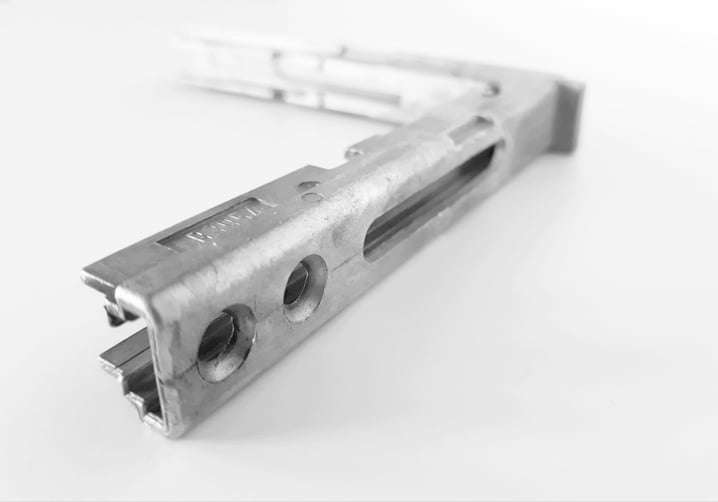
Case
The case is a component of the opening and closing mechanisms of doors and windows. The piece has a technical function because it holds together and covers the linkage mechanism of transmission of the rotary motion in linear but, in addition to this function, as in the previous case, the case is distinguished by a noticeable aesthetic value because it is directly inserted in the living environment. Precisely for this aesthetic value the case undergoes superficial treatments aimed at increasing the superficial quality: this component, depending on the customer needs, can be coated or chromed.
Choosing Zamak for the production of the case is eventually profitable not only from a technical and aesthetical point of view, as already observed, but also from an economic perspective. In fact, zinc alloys allow the die caster to diminish the number of secondary operations because, thanks to their fluidity characteristics, they allow the realization of complex shapes. Thereby, thanks to Zamak, it is possible to obtain a number of details and micro details already during casting phase, without having to perform mechanical operations in other phases of the productive process.
For a further analysis of the characteristics of zinc we suggest you to visit the page from the International Zinc Association website.
Moreover, still concerning saving, the possibility of processes automation given by its technical characteristics makes Zamak competitive in comparison to other metals. In the specific case of the realization of this component it has been possible to automate the casting process up to the complete threading of the object without the contribution of personnel and therefore with a consistent saving on the cost of direct operators.
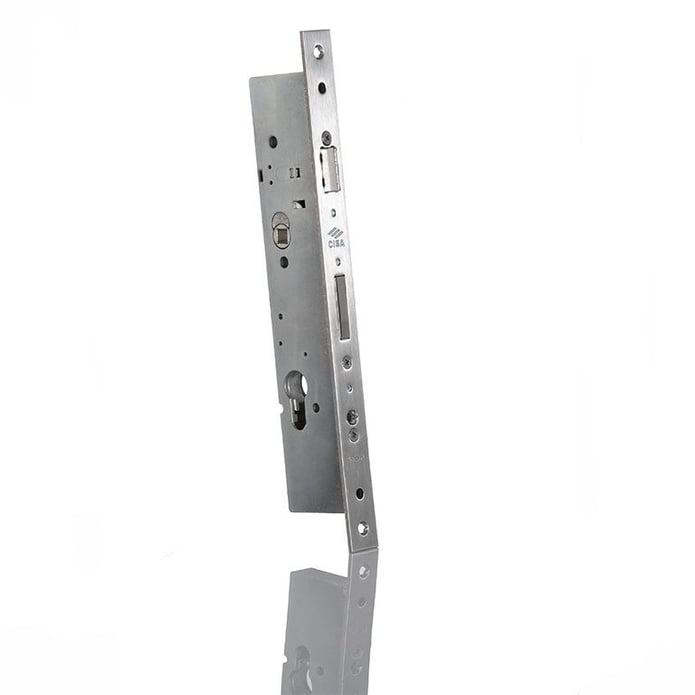
Case for panic exit handles
The case for panic exit handles is the housing of the mechanism that is connected to the central handle that allows the opening of the door. Every panic exit handle has two lateral cases that cover the opening mechanisms and they perform both a technical and aesthetical function.
Relatively to the aesthetical function, the use of zinc alloys makes it possible to perform a great variety of finishing aimed at obtaining functional or aesthetical objectives, such as, for example, the treatments to protect the component from weathering. This allows a great freedom of choice for product designers: in this way they can follow functional criterions without renouncing aesthetical factors.
Also relatively to technical aspects, the choice of zinc alloys provides actual advantages to the productive process. The possibility of producing components with thin walls thickness allows the die caster to create components employing less raw material in comparison to other metals, with a self-evident advantage in terms of costs for raw material and for energy necessary for the change of state.
In the specific case of the external case for panic exit handles various analysis, conducted with specific simulation software, made it possible to obtain an optimized product with a noticeable reduction of wall thickness starting from the previous design provided by the customer.
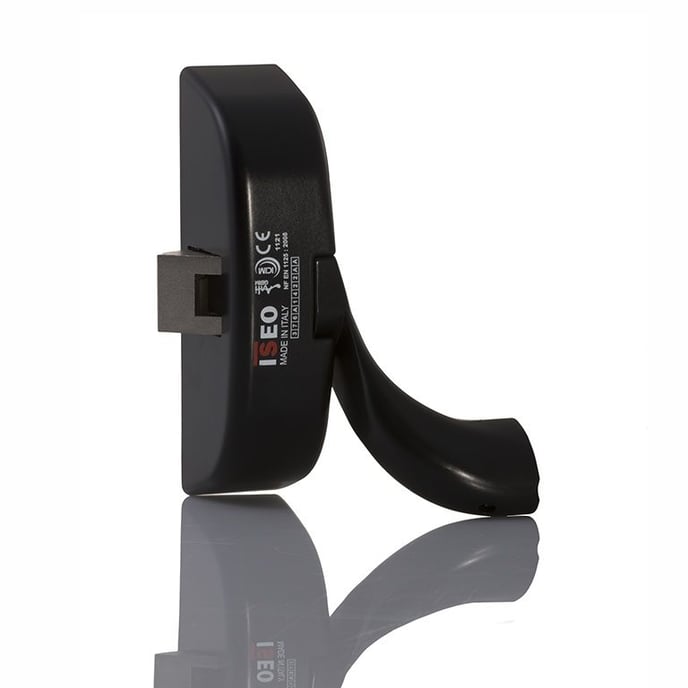
Zinc alloys for automated windows and doors
As defined, if for some zinc components for doors and windows frames die casting is a technology that has been used for a long time, for some others components, which are more innovative and modern, this kind of production is substantially a new field. Home automation and associated technologies are growing steadily and so is the smart locks market. If it is true that doors will still have hinges, locks and handles it is also true that it is necessary to reconsider these components to make them able to support automation and electronics. However, new functionalities require the design of new solutions: in fact, for example, the presence of circuits and electronic commands necessary implies an activity of redesign and redefinition of the components. Thanks to their fluidity and their chemical-physical characteristics Zinc alloys, manufactured with the die casting process, allow the creation of complex shapes and thin walls resulting therefore particularly suitable for the production of components for home automation. In particular, two components that can be produced with zinc alloys appear with an increasing frequency on the market, so much that they have become common used. These components are the keypad case for remote opening of windows and doors and the cover plate for electronic locks.
Plate for electronic locks
The first of these zinc alloys for windows and doors components is the covering plate of electronic locks. The plate, considering its covering function, has to primary meet aesthetical requirements. However, in parallel, it also has an housing function for the electronic components that allow the opening of the locks: for this reason, as in other previously mentioned cases, besides the aesthetical value also technical aspects have to be considered.
The die cast, after the casting process, is separated from the injection channel, then it is thermal deburred and threaded. Afterwards it is prepared for the superficial treatment with polishing process and it is galvanized to obtain the finishing of satin or polished chroming and gliding. These treatments increase not only the aesthetic value of the product but also its superficial resistance and, as a consequence, its lifetime. Zinc alloys, also in this case, allow the producer to obtain, through optimized and automated processes, products with an excellent superficial quality at competitive prices in comparison to those for the same product realized with other metals.
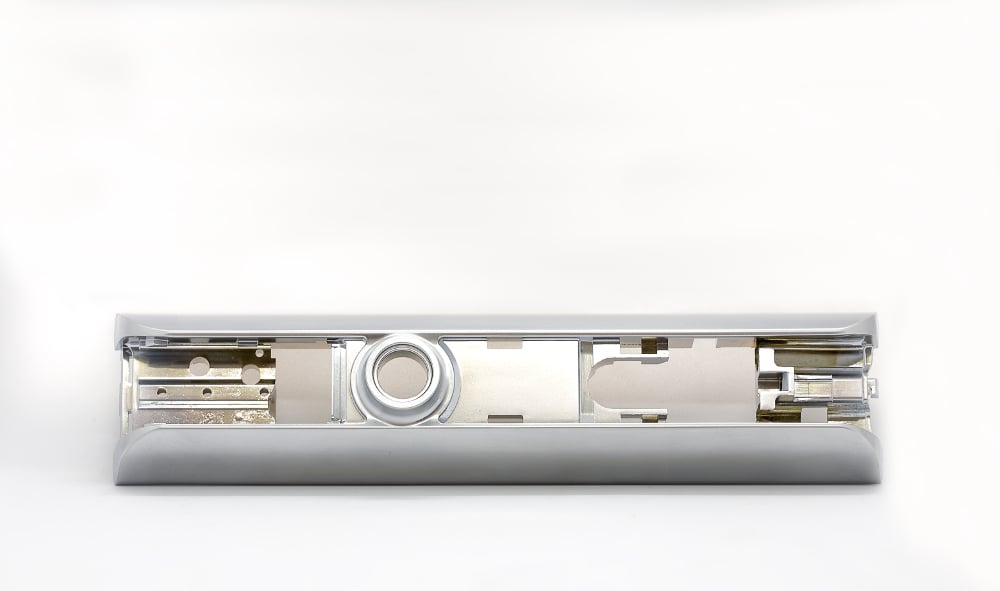
Keypad case for the remote opening of windows and doors
A second zinc component for doors and windows frames that is increasingly common is the keypad that allows the opening of doors and gates by code. Also in this case the requirements are both technical and aesthetical: the piece, exposed to the weather conditions, has to resists salt spray tests, to keep an excellent aesthetical quality over time and to host, protecting them, the internal electronic components. Zinc, characterized by dimensional stability and resistance to the different weather and climatic conditions, proves to be an optimal choice. Finally, the capability to take complex shapes and to achieve an high level of detail and precision allows the customer to design the component with freedom in such a way that he or she can obtain the most satisfying product.
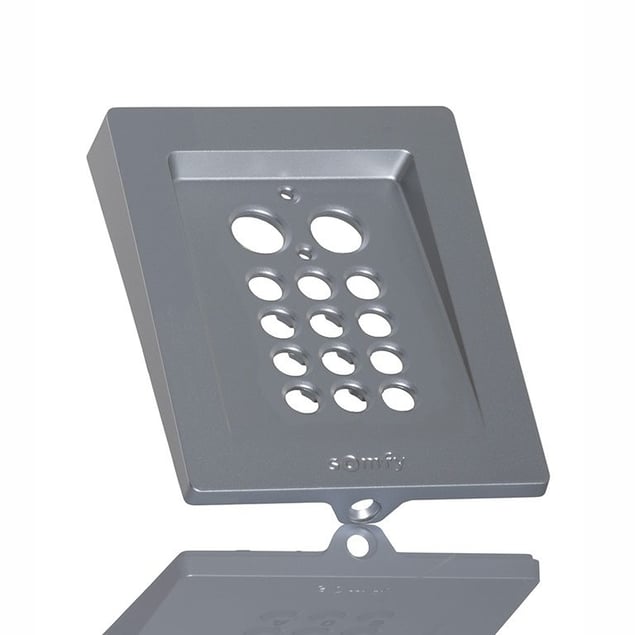
Conclusion
The employment of zinc alloys through hot chamber die casting process, in comparison to other alloys or technologies, often results in an economic advantage for the producer of components for doors and windows frames. In fact Zamak allows the reduction of secondary operations and the automation of a consistent part of the processes: with a great saving in terms of time and costs. Moreover, the design freedom, the possibilities offered by optimization and the great variety of superficial treatments that it is possible to perform on zinc components for windows and doors frames allow the achievement, without waste of time and material, of products that are compliant with the requirements defined by the customer and that are ready for the final user.
To always be up-to-date with die casting industry, subscribe to our blog.

